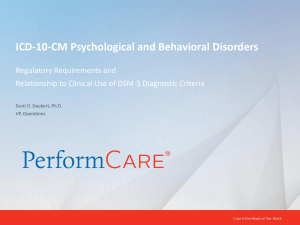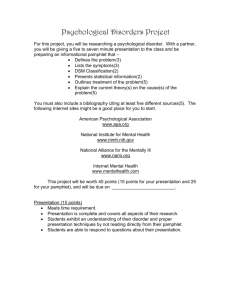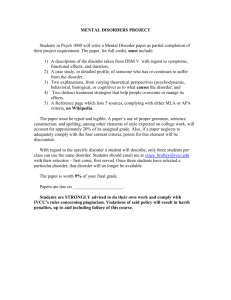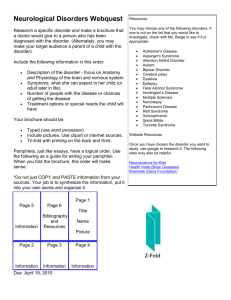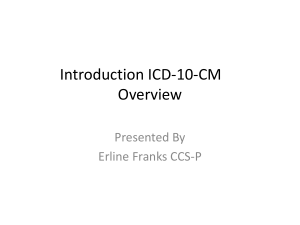ICD-10-CM_Summary_for_the_Assembly
advertisement
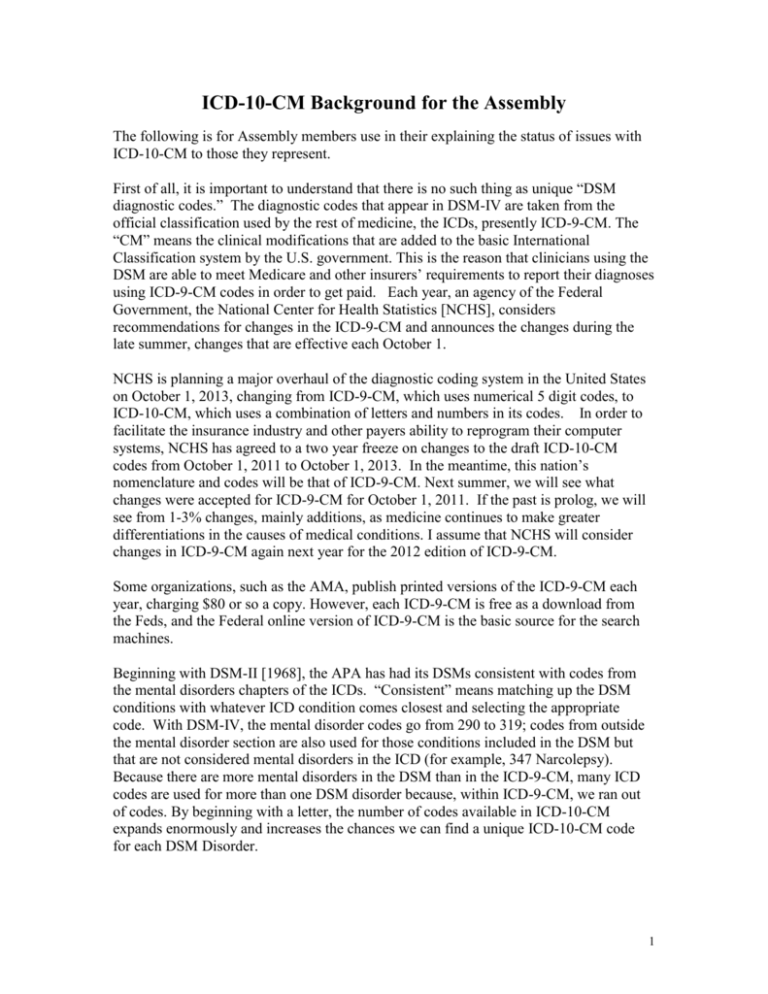
ICD-10-CM Background for the Assembly The following is for Assembly members use in their explaining the status of issues with ICD-10-CM to those they represent. First of all, it is important to understand that there is no such thing as unique “DSM diagnostic codes.” The diagnostic codes that appear in DSM-IV are taken from the official classification used by the rest of medicine, the ICDs, presently ICD-9-CM. The “CM” means the clinical modifications that are added to the basic International Classification system by the U.S. government. This is the reason that clinicians using the DSM are able to meet Medicare and other insurers’ requirements to report their diagnoses using ICD-9-CM codes in order to get paid. Each year, an agency of the Federal Government, the National Center for Health Statistics [NCHS], considers recommendations for changes in the ICD-9-CM and announces the changes during the late summer, changes that are effective each October 1. NCHS is planning a major overhaul of the diagnostic coding system in the United States on October 1, 2013, changing from ICD-9-CM, which uses numerical 5 digit codes, to ICD-10-CM, which uses a combination of letters and numbers in its codes. In order to facilitate the insurance industry and other payers ability to reprogram their computer systems, NCHS has agreed to a two year freeze on changes to the draft ICD-10-CM codes from October 1, 2011 to October 1, 2013. In the meantime, this nation’s nomenclature and codes will be that of ICD-9-CM. Next summer, we will see what changes were accepted for ICD-9-CM for October 1, 2011. If the past is prolog, we will see from 1-3% changes, mainly additions, as medicine continues to make greater differentiations in the causes of medical conditions. I assume that NCHS will consider changes in ICD-9-CM again next year for the 2012 edition of ICD-9-CM. Some organizations, such as the AMA, publish printed versions of the ICD-9-CM each year, charging $80 or so a copy. However, each ICD-9-CM is free as a download from the Feds, and the Federal online version of ICD-9-CM is the basic source for the search machines. Beginning with DSM-II [1968], the APA has had its DSMs consistent with codes from the mental disorders chapters of the ICDs. “Consistent” means matching up the DSM conditions with whatever ICD condition comes closest and selecting the appropriate code. With DSM-IV, the mental disorder codes go from 290 to 319; codes from outside the mental disorder section are also used for those conditions included in the DSM but that are not considered mental disorders in the ICD (for example, 347 Narcolepsy). Because there are more mental disorders in the DSM than in the ICD-9-CM, many ICD codes are used for more than one DSM disorder because, within ICD-9-CM, we ran out of codes. By beginning with a letter, the number of codes available in ICD-10-CM expands enormously and increases the chances we can find a unique ICD-10-CM code for each DSM Disorder. 1 Coding distinctions can be extremely important for purposes of justifying reimbursement because as far as insurers are concerned, the only distinctions that are typically recognized in their computer systems are those reflected in the diagnostic codes. For example, in order to help justify the role of the psychiatrist in the treatment of dementia, in 1990’s the APA requested that a new coding option be added to the diagnostic code for dementia in order to allow the psychiatrist to indicate the presence of accompanying behavioral disturbances that would justify the involvement of a psychiatrist in the management of the patient. The ICD-10-CM section of most interests to us is Chapter F, mental health disorders. Other chapters in the ICD include diagnostic codes that can be important in the practice of psychiatry as well, especially Chapter G [Diseases of Nervous System], Chapter R [Signs, Symptoms, Abnormal Lab Findings], Chapter T [Injuries, including abuse], and Chapter Z [Factors influencing health status or reasons for contacting health services]. The diagnostic codes in DSM-III, DSM-III-R, and DSM-IV are all derived from the ICD9-CM system which first implemented in the United States in 1978. While the DSM’s were not obligated to use the ICD-9-CM terminology, they were required to use the ICD9-CM codes, so for each DSM disorder, APA selected the ICD-9-CM diagnostic code that came closest. Over the years, at APA’s request, NCHS updated the ICD-9-CM terminology so that it more closely reflected the terms used in the DSM and to requests new codes for DSM disorders and specifiers as they were added to DSM-III-R and DSMIV. As noted above, because of severe limitations in the number of available codes, many of these coding requests could not be accommodated. However, when NCHS started work on the development of the ICD-10-CM in the last 1990’s, they asked Dr. Michael First, editor of DSM-IV, who was consulting with APA, to assist in the development of the development of the mental disorders chapter, allowing APA to request unique diagnostic codes for virtually all of the disorders in DSM-IV and the adoption of the DSM terminology as the official names for the disorders. (The only exception was that some substance groups were required to share codes because of coding limitations). Thus, at the present time, the adoption of ICD-10-CM in this country will have a sticker shock at first glance with most psychiatric disorders beginning with “F.” A second glance will be comforting, however, when one notes that Chapter F is DSM-IV-TR recoded. As to Chapters R, T and Z, the Assembly review found no substantial additions to recommend to the Board of Trustees at this time. In developing DSM-5, we will have to determine which diagnostic codes from ICD-10CM that we want to assign to the disorders in DSM-5. The lack of inclusion of an ICD10-CM disorder in DSM-5 will not cause that name and code to be removed from ICD10-CM. For example, if we decide not to have Narcissistic personality disorder in DSM5, it still remains in ICD-10-CM. What is missing from the ICD-10-CM for the practitioner is not name and code (which is part of the ICD-10), but the APA’s definition of that Syndrome. For the viability of DSM-5, it is essential that definitions of Disorders 2 that practitioners will be pulling up in their search engines be available. Obviously, it does not have to be 100%, but the APA will need to be careful that the DSM-5 be very useful to as many psychiatrists as practical to assure it viability. We need to be careful not to take the position that the APA can dictate what is to be used. That might work for a book, but not for the search-engine world. The percentage of practitioners opening the DSM-IV-TR book as opposed to a search engine to obtain name and code of a disorder is rapidly shrinking. Many of you and those you represent have not opened a book recently to find a code number you have forgotten because all you have to do is search “ICD-9-CM” and the name of the disorder and the code comes up immediately. In the ICD-10-CM arena, of which DSM-5 will be a part, clinicians will get their codes free. DSM-5 becomes relevant if they want to know more than name and code. The APA will want to be sure that DSM-5 remains relevant to whatever codes psychiatric practitioners will be using. When practitioner pulls up “ICD-10-CM” and “Asperger’s Syndrome,” “Schizophrenia Catatonic Type,” “Fetal Alcohol Syndrome,” “Narcissistic Personality Disorder,” “Schizoid Personality Disorder,” “Premenstrual Dysphoric Disorder,” and so forth, there is no book between the practitioner and ICD-10-CM. ICD-10-CM has no “Appendix” location. In the electronic ICD-10-CM world, DSM-5 will have a greater challenge to establish its usefulness for the typical clinician than the prior DSMs. The APA Board of Trustees was told on December 12 that the DSM-5 Task Force may recommend to the Board that the APA ask NCHS to add some of the following to ICD10-CM: Autism Spectrum Disorder Disinhibited Social Engagement Disorder Disruptive Mood Dysregulation Disorder Factitious disorder imposed on another Major Neurocognitive Disorder Minor Neurocognitive Disorder Mixed Anxiety/Depression Non-Suicidal Self Injury Personality Disorder, Traits Specified Reactive Attachment Disorder Attenuated Psychotic Symptoms Disorder Anxious Depression Complicated/Prolonged Grief Hoarding Disorder Olfactory Reference Syndrome Skin-Picking Disorder [Two thoughts were removed after the Assembly review: Hypersexual Disorder and Paraphilic Coercive Disorder.] While NCHS had apparently set a deadline, today – January 7, for submission of additions to ICD-10-CM, the APA [credit, I gather, goes to David Kupfer and Darrel 3 Regier] has apparently obtained considerable flexibility as our submissions dates on when the APA can submit additions to ICD-10-CM. [Subtractions from ICD-10-CM are very likely to be beyond our reach.] When those you represent ask you if DSM-5 will have a life in the search-engine world, I would suggest the answer is strong “yes” on two grounds. First, it is important that the practitioner and researcher use the definitions that encourage reliability in the field. We don’t want to lose the ground that DSM-III, IIIR and IV achieved. DSM-5 needs to be sure that it defines the conditions psychiatric practitioners pull up in their search. Second, when we were developing DSM-III, it was decided [primarily by Spitzer] to go beyond just the definitions, that is, beyond the criteria sets, and provide other core information about each Disorder in a succinct manner. Allen Frances and Michael First kept that goal in mind with DSM-IV and DSM-IV-TR. The main reason that Dr. First was asked to develop DSM-IV-TR, 2000, was to enhance the quality of the text. The result is that the DSM has become THE book on psychopathology around the world. This is one of the reasons that even today, within the shadows of the publication of DSM5, 2013, DSM-IV-TR sales continue to be impressive. The DSM-5 Task Force has developed a comprehensive outline to be followed for the authors of each Disorder, an outline that should assure that DSM-5 remains THE book of psychopathology Roger Assembly Liaison to the DSM-5 Task Force 7Jan2011 4
